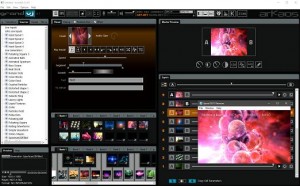Aktuelle News & Schlagzeilen
Arkaos launches GrandVJ 2.5
Arkaos has launched GrandVJ 2.5, a new version of its GrandVJ software designed for intuitive control of video sources by VJs and video operators working in all ‘live’ scenarios. The new version’s features include Spout output in both Instant and VideoMapper modes (using Spout allows GrandVJ to integrate and share both inputs and outputs in real-time with a large number of other applications) and DMX Merger in the LEDMapper with GrandVJ XT (allows a VJ/operator to interact with a lighting designer and merge the generated video content with controls such as pan and tilt which are created by a lighting console; in the reverse direction, it enables the LD to apply effect like strobe over the content being displayed/created by the VJ).
GrandVJ 2.5 also features: Support for complex DMX fixtures like moving heads (enabling users to include pixel-based moving light fixtures in their shows); Improved Art-Poll based node discovery in the LEDMapper (makes it easier to identify fixtures that are available on the network); Auto-unicast for optimized Art-Net network setup (using unicast - one sender, one receiver - rather than broadcast puts less pressure on all fixtures that are available on the network); Support for Draft Devices in the Kling-Net Mapper to prepare shows offline (shows with multiple fixtures can be prepped in advance). All applications run in 64 bits: for speed, minimal latency and seamless realtime operation.
There is also improved support for DPI display scaling and for international characters, as well as faster movie playback for ProRes on Mac and Windows and more rapid YUV colour conversion for all Mac codecs. The v2.5 LED Mapper now has the facility to merge the Art-Net input with the LEDMapper output, and an Editor has been added to create fixtures with any format of DMX pixel-mapping including channel gaps.
The upgraded Spout version 2.006 offers increased texture sharing compatibility. With all v2.5 applications now in 64 bits - as Apple does not provide 64-bit QuickTime - GrandVJ now uses FFmpeg to read all QuickTime codecs. There is no longer any need to install QuickTime on Windows (like previous versions of GrandVJ where QuickTime was used to play ProRes encoded videos). GrandVJ automatically sends output through spout video frame sharing, but the application will now only perform a transfer if a Spout receiver is listening.
SCHLAGZEILEN
news archiv
suche
© 1999 - 2025 Entertainment Technology Press Limited News Stories








